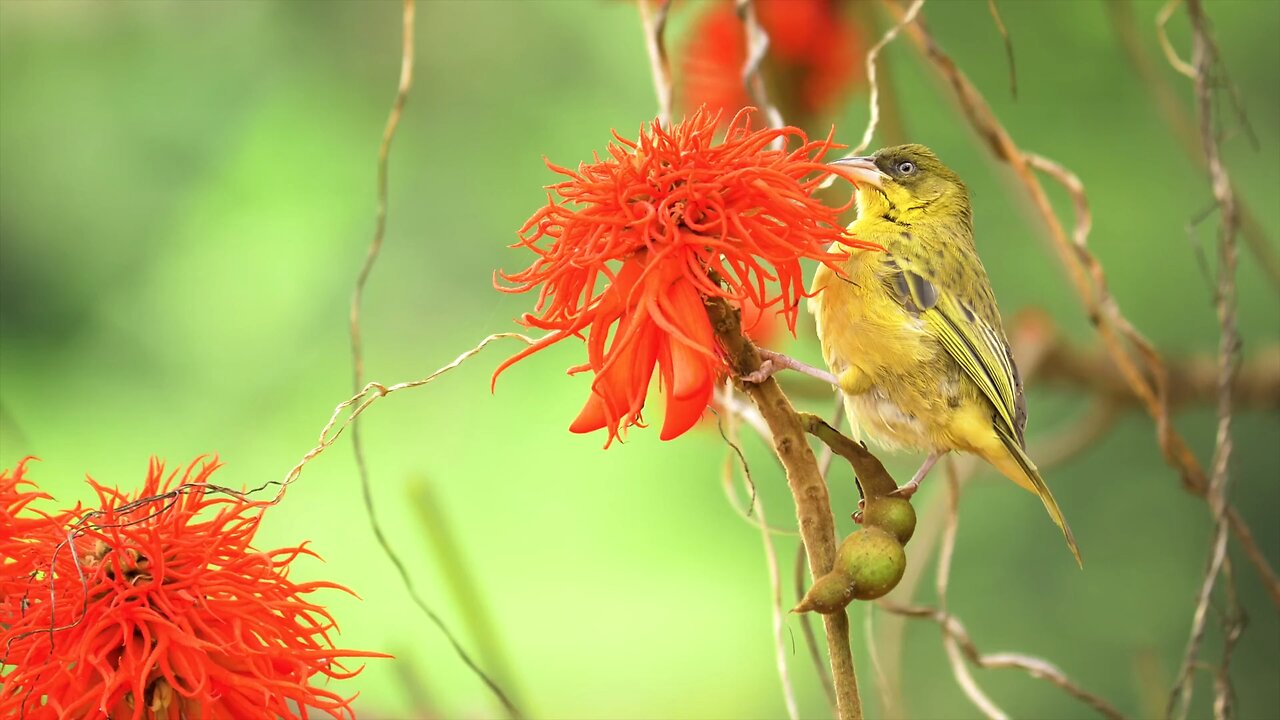Premium Only Content

"Erythrina abyssinica: The Vibrant Flame Tree of Africa"
Erythrina abyssinica is a medium to large deciduous tree that typically reaches heights of 10 to 15 meters, though it can grow taller under favorable conditions. Its broad, spreading crown is often irregularly shaped, and the trunk is covered in a thick, corky bark that is gray to brownish in color. The bark often features prominent ridges and furrows, and it is sometimes spiny.
### Leaves
The leaves of Erythrina abyssinica are compound, trifoliate, meaning each leaf is composed of three leaflets. These leaflets are broadly ovate to elliptic in shape, measuring up to 15 cm in length. They have a glossy, dark green upper surface, while the underside is paler and sometimes covered with fine hairs.
### Flowers
The tree is renowned for its vibrant flowers, which appear in dense clusters or racemes at the ends of the branches, typically when the tree is leafless or just beginning to produce new leaves. The flowers are tubular and bright red to orange, resembling coral spikes, hence the common name "coral tree." These flowers are rich in nectar, attracting a variety of pollinators, particularly birds.
### Fruit and Seeds
After flowering, Erythrina abyssinica produces seed pods that are cylindrical and slightly curved. These pods are dark brown to black when mature and can reach up to 30 cm in length. Inside, they contain several kidney-shaped seeds that are usually bright red or orange.
### Habitat and Distribution
Erythrina abyssinica is widely distributed across tropical and subtropical Africa, from Ethiopia and Sudan in the north, down through East Africa to South Africa in the south, and westward to Angola and the Congo Basin. It typically grows in open woodlands, savannas, and along riverbanks, often on well-drained soils.
### Uses
**Traditional Medicine:** The tree has a variety of uses in traditional medicine across its range. The bark, roots, and leaves are used to treat ailments such as fever, respiratory infections, and gastrointestinal issues.
**Agriculture:** It is also planted as a shade tree in coffee and cocoa plantations due to its broad canopy and deep root system, which does not compete with crops for nutrients.
**Cultural Significance:** The tree holds cultural significance in many African communities, where it is sometimes used in rituals and ceremonies. The seeds are also used in traditional jewelry and ornamentation.
**Wood:** The wood of Erythrina abyssinica is soft and light, making it easy to work with, but it is not durable and is prone to termite attack. It is sometimes used for making utensils, carvings, and other items.
### Ecological Role
Erythrina abyssinica plays a vital ecological role in its environment. The flowers are a critical food source for nectar-feeding birds, such as sunbirds and weaver birds, as well as insects. The tree also helps in soil stabilization and provides habitat for various species of fauna.
-
 LIVE
LIVE
Tucker Carlson
1 hour agoTony Aguilar Details the War Crimes He’s Witnessing in Gaza
3,951 watching -
 UPCOMING
UPCOMING
Badlands Media
4 hours agoBadlands Daily: July 31, 2025
3.16K -
 LIVE
LIVE
Matt Kohrs
10 hours agoHUGE Earnings Beat, Inflation Data & New Record Highs || Live Trading Options & Futures
823 watching -
 19:44
19:44
Bearing
1 hour agoWorld’s CRAZIEST Feminist Wants AMERICANS to WAKE THE F*** UP 🦅💥
44117 -
 LIVE
LIVE
Randi Hipper
10 minutes agoUNITED STATES BITCOIN RESERVE IS COMING! WHITE HOUSE CRYPTO REPORT EXPLAINED
52 watching -
 LIVE
LIVE
Wendy Bell Radio
6 hours agoBurn Baby Burn
7,680 watching -
 LIVE
LIVE
JuicyJohns
1 hour ago $0.63 earned🟢#1 REBIRTH PLAYER 10.2+ KD🟢$500 GIVEAWAY SATURDAY!
131 watching -
 LIVE
LIVE
LFA TV
11 hours agoLFA TV ALL DAY STREAM - THURSDAY 7/31/25
4,681 watching -
 1:02:45
1:02:45
Game On!
18 hours ago $2.56 earnedFootball is BACK! NFL Hall of Fame Game 2025
17.3K2 -
 1:55:56
1:55:56
FusedAegisTV
23 hours ago3rd Party Partner Showcase Nintendo Direct! REACTION 7.31.2025 | FusedAegis Presents
13.2K